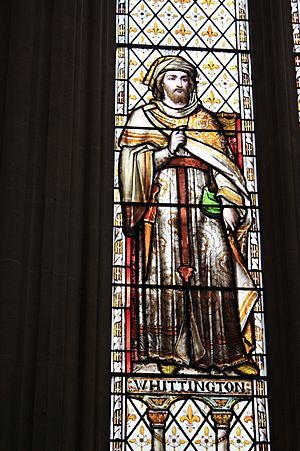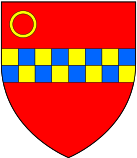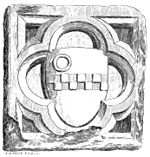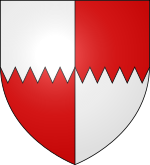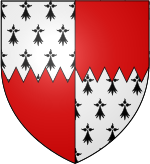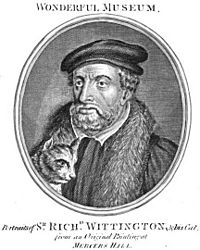Richard Whittington facts for kids
Richard Whittington (around 1354 – March 1423) was a very successful English merchant and politician. He lived in the City of London during the late Middle Ages. He is also the real person who inspired the famous English folk tale Dick Whittington and His Cat.
Whittington was the Lord Mayor of London four times. He was also a member of parliament and a Sheriff of London. During his life, he paid for many public projects. These included new drainage systems in poor parts of London and a hospital ward for mothers. He left his large fortune to create a charity. This charity, called the Charity of Sir Richard Whittington, still helps people today, nearly 600 years later.
Contents
Who Was Richard Whittington?
Richard Whittington was born around 1354. His family was wealthy and came from Gloucestershire. He was the third son of Sir William Whittington, who was also a Member of Parliament.
Early Life and Business
Because Richard was a younger son, he wouldn't inherit his father's land. This was due to a system called primogeniture, where the oldest son inherited everything. So, Richard was sent to London to learn a trade. He became an apprentice to a mercer, someone who sold fine fabrics.
He became a very successful merchant. He sold expensive imported goods like silks and velvets. Many of his customers were royalty and nobles. He also exported English woollen cloth to Europe. From 1392 to 1394, he sold goods worth a lot of money to King Richard II.
Whittington also started lending money in 1388. He preferred this to buying lots of property. By 1397, he was even lending large amounts of money to the king.
Whittington's Political Career
In 1384, Whittington became a Councilman for the City of London. In 1392, he was part of a group sent to meet the king. The king had taken control of London's lands because of problems with its government.
By 1393, Whittington became an alderman. This is a senior member of a city council. He was also made Sheriff of the City of London. He joined the Worshipful Company of Mercers, a powerful group of merchants.
In June 1397, the king chose Whittington to be the Lord Mayor of London. This happened after the previous mayor died. Whittington quickly made a deal with the king. He helped the City of London buy back its freedoms for a large sum of money. Because of this, the people of London formally elected him mayor later that year.
When King Richard II was removed from power in 1399, it didn't hurt Whittington's career. He had already been supplying goods to the new king, Henry IV. He also lent King Henry IV a lot of money.
Whittington was elected mayor again in 1406 and 1419. He also served as mayor for the merchants in Calais in 1407. In 1416, he became a Member of Parliament for the City of London. He was also important to King Henry V. He lent the king money and helped him with important tasks, like overseeing the building of Westminster Abbey. Even though he was a moneylender, he was trusted enough to be a judge in cases about unfair lending practices in 1421. Whittington also helped collect taxes and import duties. He even won a long argument with the brewers about the prices of ale.
Whittington's Marriage
In 1402, when he was 48, Richard Whittington married Alice FitzWaryn. She died in 1411, and they did not have any children. Alice was the daughter of Sir Ivo FitzWaryn, who was also a Member of Parliament. Her family was old and powerful.
Whittington's Generosity
Richard Whittington gave a lot of his money to the City of London during his lifetime. He also left more money in his will. He helped pay for:
- The rebuilding of the Guildhall, a main building in London.
- A special ward for unmarried mothers at St Thomas' Hospital.
- New drainage systems in areas like Billingsgate and Cripplegate.
- The rebuilding of his local church, St Michael Paternoster Royal.
- A large public toilet that could seat 128 people, called Whittington's Longhouse. It was cleaned by the River Thames at high tide.
- Most of the library at Greyfriars.
He also provided housing for his apprentices in his own home. He even made a rule to stop apprentices from washing animal skins in the River Thames in cold weather. This was because many young boys had died from the cold or by drowning.
Death and Legacy
Whittington died in March 1423, when he was about 68 or 69 years old. He was buried in the church of St Michael Paternoster Royal, where he had given a lot of money. His tomb is now lost.
What He Left Behind
Since he had no children, Whittington left a huge sum of £7,000 to charity in his will. This was a massive amount of money back then. Some of this money was used to:
- Rebuild Newgate Prison and provide better accommodation for the Sheriffs.
- Build the first library in the Guildhall, which is now the Guildhall Library.
- Repair St Bartholomew's Hospital.
- Create his 'college', which was an almshouse (a place for poor people to live) and a hospital.
- Install some of the first public drinking fountains.
The almshouses were moved in 1966 to Felbridge. Today, sixty elderly women and some married couples live there. The Whittington Charity also gives money to people in need every year through the Mercers' Company.
The Whittington hospital in Archway was named after him when it was built in 1948, to honor his charitable gifts.
Dick Whittington – The Story Character
Because of all the good things Richard Whittington did, he became a well-known character in an English story. This story was made into a play in 1604. In the 1800s, it became a popular pantomime called Dick Whittington and His Cat. This play is only loosely based on the real Richard Whittington.
There are different versions of the traditional story. It tells how Dick, a poor boy from Gloucestershire, goes to London to find his fortune. He is often with, or later gets, his cat. At first, he doesn't do well and thinks about going home. But as he leaves the city, climbing Highgate Hill, he hears the Bow Bells of London ringing. He believes they are sending him a message. Today, there is a large hospital on Highgate Hill named the Whittington Hospital, because of this part of the story.
A famous rhyme from the tale is:
Turn again, Whittington,
Once Lord Mayor of London!
Turn again, Whittington,
Twice Lord Mayor of London!
Turn again, Whittington,
Thrice Lord Mayor of London!
After returning to London, Dick has many adventures. In one version, he travels on a ship. His cat catches many rats, which makes him popular and helps him earn money. In another version, he sends his cat away, and it is sold for a lot of money, making his fortune. Eventually, he becomes rich, marries his master's daughter, Alice Fitzwarren (the same name as the real Whittington's wife), and becomes Lord Mayor of London three times. The story says three times, but the real Whittington was mayor four times.
The real Richard Whittington was never poor; he came from a wealthy family. Also, there is no proof that he owned a cat. The idea of his fortune coming from a cat might have come from an old Persian folk tale. This tale was about an orphan who got rich because of his cat.
Some people think the cat legend became popular because of a 17th-century picture by Renold Elstracke. In this picture, Whittington's hand rested on a cat. However, the picture probably just showed a story that was already popular. It's even thought that the "cat" in Elstracke's picture was originally a skull and was changed later to match the popular story and sell more prints!
There was also a painting of Whittington with a cat at Mercer Hall. But parts of the painting were cut off, and the date "1572" on it might have been added later.
See also


